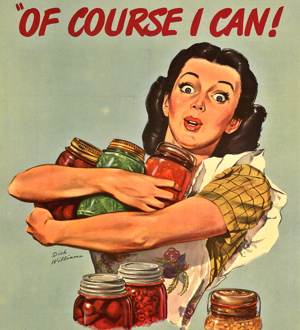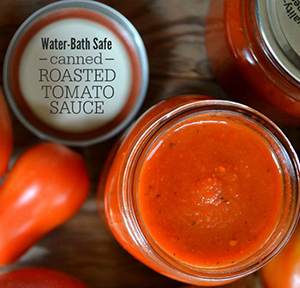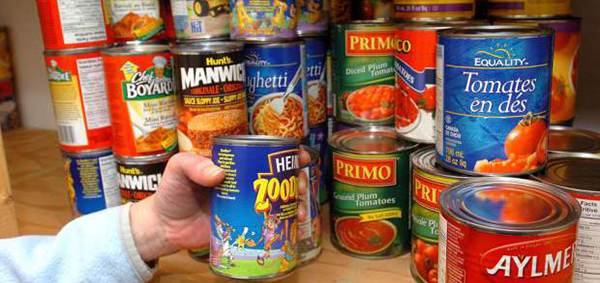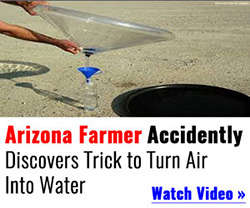When we think of prepping for survival, one of the first things that come to mind is storing away food and what first comes to mind for most people is canned food. Canned food is readily available, simple to store, and easy on the budget. But there are a number of myths about canned food that are being passed around and these myths can easily be confused with the facts. These myths sometimes make people think twice about whether or not canned food is the best choice as a method of storing away food for bad times.
We are here to set the record straight. We reveal the top myths about canned food in general, followed by the myths and facts about canning your own food. All of this will then be put into the context of prepping and long-term storage of canned foods.
General Myths and Facts
 Myth #1: Canned foods are loaded with preservatives
Myth #1: Canned foods are loaded with preservatives
No! The process of canning makes the use of preservatives unnecessary. Canned food is heated to a high enough temperature and pressure that it kills any bacteria that would pose a threat. Fruit has a high acidity level, which allows it to be canned with only the need for high heat, but other foods, including vegetables, beans, and meats, are put under high heat and pressure to can them. There is nothing added to the food other than desired sweeteners or seasoning. As the food is canned, an air-tight seal is formed that keeps bacteria out and freshness in.
Myth #2: Canned foods are not nutritious compared to fresh or frozen
It’s definitely true that the most nutritious food is fresh food. The sooner it is eaten after being harvested or killed, the higher the nutritional content of the food. Cooking can also cause some nutritional losses from some foods. However, canned foods, particularly those that are canned close to harvest, retain the majority of their nutrients.
Canned foods retain their full fiber and protein content, effects on carbohydrates and fatty acids are negligible, and there are only minor losses to some vitamins. In fact, canning some fruits and vegetables increases their nutritional impact. When canned tomatoes have a higher level of lycopene; a number of vegetables, such as carrots and spinach, have higher levels of carotene; and many fruits and vegetables have a higher availability of antioxidants.
Myth #3: Canned foods are processed foods
If you think about it, as soon as you cook any food, you are processing it. Roasting a chicken, boiling potatoes, baking bread are all methods of processing the food into a form in which we can/prefer to eat it. Canned foods are really no more processed than regular cooked foods. The primary difference is that they are cooked at higher temperatures and pressures and then vacuum-sealed.
Myth #4: Canned food tastes bad
Let’s face it. The taste of a can of peaches is delightful. Yum! Canned foods, when canned at the height of ripeness and soon after harvest, retain their flavor at least until their expiry date and longer if properly stored in cool, dry environment.
Myth #5: Canned food has high sodium content
It’s true that canned foods often have salt in them. However, this is not required for the canning and preservation of these foods. Salt is added simply for the benefit of flavor in just the same way you would add salt to your French fries or a bowl of soup. There are plenty of low-sodium options when it comes to canned foods.
Related: How to Prepare For the Coming Food Crisis
Myths and Facts about Canning Your Own Food
The above myths and facts were about canned food in general, including what you buy off the grocery store shelves, but many people prefer to can their own food. Perhaps they grow a garden or they look for bulk produce on sale and then they want to can as much of it as possible. Knowing what you are doing when canning your own food can mean the difference between nutritious and delicious food and food that will make you deathly ill. Here are some myths and facts about canning your own food.
 Myth #1: Vegetables can be canned in a hot water bath canner; simply boiling them long enough will make them safe for consumption
Myth #1: Vegetables can be canned in a hot water bath canner; simply boiling them long enough will make them safe for consumption
The fact is only foods that are high in acidity can be canned simply by boiling them. This means fruit can be canned in a water bath canner (reaches 212 degrees Fahrenheit), but low-acid foods, such as vegetables, beans and legumes, meat and dairy, must be canned with a pressure canner. These low-acid foods can cause botulism, which is a food-borne illness caused by Clostridium botulinum spores that can kill. The high pressures of the pressure canner will increase the temperature of the canning bath to 240 degrees Fahrenheit, effectively killing off the Clostridium botulinum spores.
Myth #2: You can safely can food in your oven
Absolutely not. Canning food in your oven is not safe, especially when it comes to those low-acid foods we talked about above.
 Myth #3: Any salsa recipe can be canned in a water bath canner
Myth #3: Any salsa recipe can be canned in a water bath canner
This is not true because it depends on the ingredients in your salsa. If there are too many low-acid foods in the salsa, then a pressure canner is required. Only salsa recipes designed for water bath canning should be used and they must be followed precisely.
Myth #4: Vegetables don’t need to be blanched prior to canning
If you want canned vegetables that have a good color, flavor, and texture, then it is highly recommended that you blanch them, which means exposing them to boiling water for a short period of time. This deactivates enzymes on the surface of the vegetables that will cause discoloration and changes in texture and flavor.
Myth #5: You can use any jars for canning
You cannot use just any jar for canning. While glass mayonnaise jars can be used, they are not the safest. The best and safest jars to use are mason jars with new lids. You can reuse the jars and rings (screw bands), but you must purchase new lids for each canning session.
Myth #6: Paraffin wax is adequate to seal jams and jellies
This is not the case. Paraffin wax will not create an airtight seal on a container. This means bacteria can still get in and the preserves can spoil.
Myth #7: Very high-acid foods, such as pickles, do not need to be put in a water bath canner
No matter how acidic a food is, it requires the recommended amount of time in the water bath canner. This is because there are some yeasts and molds that will survive even in a high-acid environment and the only way to kill them is via high temperatures.
Myth #8: You have to make the rings on mason jars super tight
The rings on mason jars only need to be tightened fingertip tight; you don’t need to use your muscles to get them really tight. The seal is formed by the lid and if the ring is too tight, it can cause the seal to fail.
Related: How to Prepare For the Coming Food Crisis
Canned Goods and Prepping
Now that you know the facts about canned goods and canning your own food, let’s finish off with a look at adding canned foods to your stores. Canned foods are an excellent and inexpensive way to store away extra food, but some people think that’s all they need. However, it is wise to stock other non-perishables, such as rice, dried beans, pasta, dried fruit, trail mix, seasonings, and honey. This will give you more variety, something that is very important when times are tough.
Also, even though canned foods have an expiry date, they are still good long after that date has come and gone, particularly if the food has been stored in a cool, dark, dry place. Even so, it’s best to rotate your stores, using up older food and adding new food to the back of the shelf. Be sure to dispose of any cans that are dented or very rusty.
All in all, canned foods are an important part of your overall preparedness plan. Buy them when they are on sale and get what you know your family eats. You will have good, nutritious food some of which you can make into a hot meal (such as soups and beans). Plus, in a pinch you can eat it straight out of the can. And don’t forget to stock up on a few can openers! You’re gonna need them!
You may also like:
How to Tell When Your Canned Foods Become Spoiled?
An Insanely Effective Way to Build a 5 Year Food Stockpile (Video)
How To Prepare Medicinal Pickled Garlic
12 Potentially Life-Threatening Errors You’re Making in Food Preparedness and Survival Strategies













1 – The dates on canned foods are not expiration dates. They are ‘best if used by’ dates.
2 – If the ring is screwed onto the jar too tightly, the air cannot escape the jar. This prevents the jar from sealing and will in most cases cause the jar to break / explode during processing.
3 – Do like ‘natives’ do. Make salsa fresh when you want salsa. Fresh salsa does not have to be made from all fresh / raw ingredients.
1. absolutely correct\
2. I hadn’t thought of that…good info
3. salsa made from all fresh ingredients is ‘pico de gallo’. If any or all ingredients are cooked in any way, it is salsa.
Also, never store home canned foods with the bands on. If the seal breaks, you want to KNOW about it! Test your seals by taking the bands off then picking the jar up by the lid. If it won’t hold, put it in the fridge or use it right away.
When your dried beans get old and hard as rocks, don’t toss them out, pressure can ’em.
Canned food, such as what you find in the grocery store, is a poor substitute for true long term storage. I myself have found that it represents maybe a 1 or 2 year shelf life at best depending on food type and storage conditions. I have also gotten quite ill eating (admittedly) rather dated canned wet-pack foods that should have otherwise been tossed out. So yes, I would say it’s okay to have a stash of this on hand, but plan on rotating it out frequently or donating it to your local food bank before it goes bad.
These guys have an informative section on shelf life:
http://foodassets.com/info/bulk-food-shelf-life.html#About%20Canned%20Food
You are so right! It’s just SAFER for familymembers that may not know signs of canned food poisoning! I opened a intact can of tomatoes past expiration (2yrs) and it vigorously oozed out of can! Other times the can top were slightly bulging. All signs of botulism. Didn’t eat those.
Food banks will not take items past the date. No matter how close. You have to eat them or toss them.
Many states and county extension offices and the feds have free information on food storage and especially home canning. One pointer, when canning, pressure cooker or just hot water canning, when placed out to cool, the lid should seat itself. The cooling will cause a vacuum and suck the lid down, many times making an audible noise, you can hear and observe as the lid is then depressed. If it does not “seal”, heat again, then cool again. If it refuses to seat, replace the lid, which should have a rubber gasket.
I do a lot of canning for an organic farm, and I have been doing it for many years. Everything in your article is excellent advice.
Using Mason jars or Mason type jars with the lids and rings is definitely the best method. I have used single tops in the past, but many did not seal properly. We eventually switched to the Mason jars and I can say we have achieved a 100% sealing record on all our products and we can thousands of jars each season.
You can buy canned tomatoes in glass jars that don’t have the same rusting and eroding problems that cans have. Also, there are a few companies that have the inside of their cans coated in a white plastic that seems to hold up for many years, too. Or, there are the home canning glass jars. I don’t know whether hot pack or cold pack, which is usually used for high-acid foods, makes a difference.
I get more programs that my brain can’t get thru. Looking for cheap prices to save dried food (5 gal, ball jars etc). Where to buy bulk supplies at (like Sam’s Club or go thru restaurant dealers) All help will be welcomed. Thank You